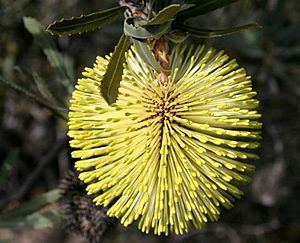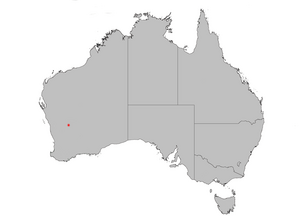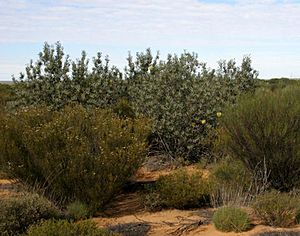Banksia rosserae facts for kids
Quick facts for kids Banksia rosserae |
|
|---|---|
 |
|
| Scientific classification | |
| Kingdom: | |
| (unranked): | |
| (unranked): | |
| Order: | |
| Family: | |
| Genus: | |
| Species: |
B. rosserae
|
| Binomial name | |
| Banksia rosserae Olde & Marriott
|
|
Banksia rosserae is a recently discovered type of Banksia plant. It grows only in the dry, inland areas of Western Australia. This makes it unique because it's the only Banksia species that lives entirely in the arid zone.
Contents
What Banksia rosserae Looks Like
B. rosserae grows as a shrub with many stems. It can reach about 2.5 to 3 meters (8 to 10 feet) tall and 3 to 4 meters (10 to 13 feet) wide. Its main stems are usually 10 to 15 centimeters (4 to 6 inches) thick.
Unlike most other Banksia plants, its grey bark is thin and peels off like paper. The leaves are a dark green color, about 5 to 12 centimeters (2 to 5 inches) long and 5 to 12 millimeters (0.2 to 0.5 inches) wide. They have jagged edges, like a saw.
The flowers are yellow and grow in the special Banksia flower spikes. These spikes are round, about 5 centimeters (2 inches) across. After the flowers fade, they form "cones" that look a bit hairy because the old flower parts stay on them. These cones usually hold 12 to 20 seed pods, called follicles. Most of these pods only open after a fire, which helps release the seeds.
How Banksia rosserae Was Discovered
Scientists aren't completely sure who first found B. rosserae. Some reports say Ann Pilkington from Kirkalocka discovered it. Others say a plant enthusiast named John Cullen found it in September 2000. Cullen was looking for another rare plant in the area when he stumbled upon two B. rosserae plants growing on a sand dune.
No matter who found it first, its existence was reported to two plant experts, Peter Olde and Neil Marriott. In 2001, Olde, Marriott, and Keith Alcock visited the area. Alcock found two more of these special Banksia plants. They realized it was a new species that hadn't been named yet. They collected samples to officially describe it.
The next year, in 2002, they officially named it Banksia rosserae Olde & Marriott. The name honors Celia Rosser, a famous artist who drew amazing pictures of Banksia plants for a three-volume book called The Banksias.
Later, in 2002, Kevin Collins and John Cullen found more B. rosserae plants nearby. They found a group of six plants and another 18 plants on public land. For a long time, no one had seen the flowers of this plant. Then, in March 2006, a big storm brought a lot of rain to the area. Two months later, scientists finally saw B. rosserae in bloom for the very first time!
Where Banksia rosserae Grows
Banksia rosserae is only found in a small area south-east of Mount Magnet in inland Western Australia. So far, only 27 plants are known to exist, all within about 20 kilometers (12 miles) of each other. This area is about 200 kilometers (125 miles) away from where other Banksia species grow. This means B. rosserae lives much deeper in the desert than other Banksia plants.
Most of the land around Mount Magnet has heavy clay soil and Acacia aneura trees. But the specific spot where B. rosserae grows is unusual. It has deep yellow sand and a type of rock called laterite. Here, it grows alongside mallee Eucalyptus trees and other plants like Grevillea, Hakea, Leptospermum, Melaleuca, Cryptandra, and Triodia. This mix of plants is more like what you'd find closer to the coast, not in the middle of the desert!
How Banksia rosserae Survives
Scientists don't know a lot about how B. rosserae lives and grows. It has a very large lignotuber, which is a woody swelling at the base of the plant. This is a great way to survive in the desert! It stores water during long dry times and energy to help the plant regrow after a bushfire. Its papery bark might also help it survive in the desert, though scientists are still studying how.
It seems that B. rosserae only flowers after it rains, so it might not flower for many years at a time. We don't know what animals pollinate its flowers, but other Banksia plants are pollinated by insects, birds, and small mammals that drink nectar. There seem to be plenty of pollinators for B. rosserae because most of its "cones" are full of seeds.
Most of the seed pods stay closed, but a few open on their own or after rain. However, most only open after a fire. This is called serotiny. This means that fire is important for the plant to release most of its seeds.
Young B. rosserae plants would have a hard time surviving a normal dry season. They probably need several years of good rain to grow strong. A bushfire followed by many years of big storms might only happen every few hundred years. This suggests that new B. rosserae plants don't get to grow very often. This could explain why all the known plants seem to be over two hundred years old!
There aren't many known threats to B. rosserae. The plants found so far look very healthy and don't have many pests. Animals like kangaroos, goats, and sheep don't seem to eat or harm them. Bushfires don't threaten them because they can regrow. Also, the area is free from a plant disease called Phytophthora cinnamomi dieback, which harms many other western Banksia species.
The biggest group of B. rosserae plants is on public land, which is being considered for a nature reserve. This means the plants will likely be protected. The only real concern is how rarely the right conditions happen for new seedlings to grow. Scientists worry that this plant is so adapted to its harsh home that its long-term future in the wild might be uncertain.
Because there are no immediate threats, B. rosserae hasn't been officially listed as rare or endangered. However, experts believe it should be a "Priority One" plant on the Department of Environment and Conservation's list. This means they keep its exact location a secret to help protect it.
Growing Banksia rosserae
Banksia rosserae is not very well known in gardens yet. In 2003, Kevin Collins reported that its seeds grow well and young plants develop quickly. In 2004, Neil Marriott said that seeds sprout well when treated with smoked water in spring. He also noted that young plants growing in sandy soil were growing slowly but steadily. He believes this plant could be useful for the cut flower industry and as a garden plant in hot, dry climates.



